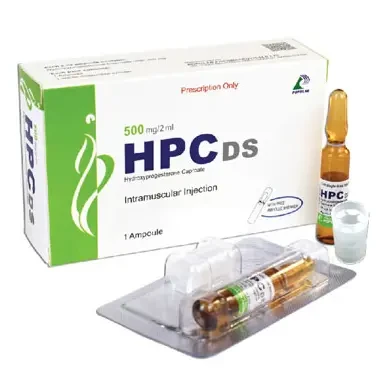Indications
HPC DS is indicated for-
Reducing the risk of preterm birth in women with a singleton pregnancy who have a history of singleton spontaneous preterm birth
Prevention of preterm labor in a singleton pregnancy for patients aged 16 years or older who have a history of spontaneous preterm birth
Reducing the risk of preterm birth in women with a singleton pregnancy who have a history of singleton spontaneous preterm birth
Prevention of preterm labor in a singleton pregnancy for patients aged 16 years or older who have a history of spontaneous preterm birth
Description
HPC DS is a synthetic steroid hormone that is similar to medroxyprogesterone acetate and megestrol acetate. It is an ester derivative of 17a-hydroxyprogesterone formed from caproic acid (hexanoic acid).
Pharmacology
The mechanism by which progesterone prevents preterm birth is not well understood, but many pathways are likely involved. (1) Progesterone plays a vital role in regulation of the female reproductive system and is important for successful implantation of the embryo and maintenance of pregnancy. It acts by binding to progesterone receptors in the uterus, ovaries, breasts and in the central nervous system. These receptors exist in 2 isoforms, PR-A and PR-B. Progesterone binding to these receptors ultimately leads to regulation of gene transcription. (2) This results in an anti-inflammatory effect which blunts the proinflammatory state that occurs with initiation of labor, and maintains uterine queiscence by stabilizing progesterone acting on the myometrium.
Dosage & Administration
Administer intramuscularly at a dose of 500 mg or 250 mg once weekly. Begin treatment between 16 weeks, 0 days and 20 weeks, 6 days of gestation. Continue administration once weekly until week 37 (through 36 weeks, 6 days) of gestation or delivery, whichever occurs first.
Administration-
Administration-
- Clean the ampoule top with an alcohol swab before use.
- Draw up 1 ml of drug into a 2 ml syringe.
- After preparing the skin, inject in the upper outer quadrant of the gluteus maximus. The solution is viscous and oily. Slow injection (over one minute or longer) is recommended.
- Applying pressure to the injection site may minimize bruising and swelling.
Contraindications
- Current or history of thrombosis or thromboembolic disorders.
- Known or suspected breast cancer, other hormone-sensitive cancer, or history of these conditions.
- Undiagnosed abnormal vaginal bleeding unrelated to pregnancy.
- Cholestatic jaundice of pregnancy.
- Liver tumors, benign or malignant, or active liver disease.
- Uncontrolled hypertension.
Side Effects
Most Common: Injection site reactions (pain, swelling, pruritus, nodule), Hives, Itching, nausea, and diarrhea. Call your doctor if you get any of the symptoms below:
- Blood clots Symptoms: Leg swelling, Redness in your leg, a spot on your leg that is warm to touch, Leg pain that worsens when you bend your foot.
- Allergic reactions: Hives, Itching, Swelling of the face.
Pregnancy & Lactation
Pregnancy: Category B. No adequate and well-controlled studies in women during first trimester of pregnancy. Teratogenic risks to infants following in utero exposure to the drug not demonstrated in a study of pregnant women receiving the drug during their second and third trimesters, as well as in a follow-up safety study of their infants. Not intended to stop active preterm labor; effect of drug for this use unknown.
Lactation: Detectable amounts of progestins identified in the breast milk of women receiving progestins. No adverse effects of progestins on breastfeeding performance or on health, growth, or development of infants, Discontinue drug at 37 weeks of gestation or upon delivery.
Lactation: Detectable amounts of progestins identified in the breast milk of women receiving progestins. No adverse effects of progestins on breastfeeding performance or on health, growth, or development of infants, Discontinue drug at 37 weeks of gestation or upon delivery.
Precautions & Warnings
- Thromboembolic disorders: Discontinue if thrombosis or thromboembolism occurs. Allergic reactions: Consider discontinuing if allergic reactions occur.
- Decreased glucose tolerance: Monitor pre-diabetic and diabetic women receiving HPC DS.
- Fluid retention: Monitor women with conditions that may be affected by fluid retention, such as pre-eclampsia, epilepsy, cardiac or renal dysfunction.
- Depression: Monitor women with a history of clinical depression; discontinue HPC DS if depression recurs.
- Jaundice: Carefully monitor women who develop jaundice while receiving HPC DS and consider whether the benefit of use warrants continuation.
- Hypertension: Carefully monitor women who develop hypertension while receiving HPC DS and consider whether the benefit of use warrants continuation.
Use in Special Populations
Pediatric Use: Not indicated for use in pediatric patients. Safety and efficacy not established in pediatric patients <16 years of age. Limited number of women<18 years of age studied; safety and efficacy expected to be the same in women >16 years of age compared with those > 18 years of age.
Geriatric Use: Not evaluated in women >65 years of age. Not intended for use in postmenopausal women. Safety and efficacy not established in postmenopausal women.
Hepatic Impairment: Contraindicated in patients with liver tumors (benign or malignant) or active liver disease. Effect of hepatic impairment on pharmacokinetics of the drug not evaluated.
Renal Impairment: Effect of renal impairment on pharmacokinetics of the drug not evaluated.
Geriatric Use: Not evaluated in women >65 years of age. Not intended for use in postmenopausal women. Safety and efficacy not established in postmenopausal women.
Hepatic Impairment: Contraindicated in patients with liver tumors (benign or malignant) or active liver disease. Effect of hepatic impairment on pharmacokinetics of the drug not evaluated.
Renal Impairment: Effect of renal impairment on pharmacokinetics of the drug not evaluated.
Overdose Effects
No adverse events associated with overdosage has been reported.
Therapeutic Class
Hormone preparations for other uses
Storage Conditions
Store at controlled room temperature between 15°C to 30°C. Protects from light. Keep out of the reach of children.


